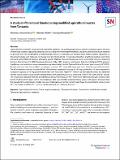| dc.contributor.author | Rwiza, Mwemezi J. | |
| dc.contributor.author | Kleinke, Matthias | |
| dc.contributor.author | Kim, Kyoung-Woong | |
| dc.date.accessioned | 2020-11-03T11:03:24Z | |
| dc.date.available | 2020-11-03T11:03:24Z | |
| dc.date.issued | 2020-10-29 | |
| dc.identifier.uri | https://doi.org/10.1007/s42452-020-03743-6 | |
| dc.identifier.uri | https://dspace.nm-aist.ac.tz/handle/20.500.12479/995 | |
| dc.description | This research article published by Springer Nature Switzerland AG., 2020 | en_US |
| dc.description.abstract | Lignocellulosic materials, abundant and renewable materials, are gaining popularity as metal scavenging agents because of their high sorption capacities, relatively low cost and environmental-friendliness. However, there is not much research to discover how the modification of different lignocellulosic materials can enhance their metal sorption capacities. In the present study, corn hulls and rice husks were pyrolyzed at 500 °C to produce biochars and these biochars were then activated using KOH and ZnCl2 as activating agents. Material characterization was done using Field Emission-Scanning Electron Microscope (FE-SEM), Brunauer–Emmett–Teller (BET) analysis, and Fourier Transform Infrared (FTIR) analysis. Equilibrium concentrations were measured using Inductively Coupled Plasma-Optical Emission Spectrometry (ICP-OES). Results indicated that the modified biosorbents removed Pb2+ more efficiently and faster than the raw hulls and husk. The KOH-treated corn husk biochar (KOH-CHB) achieved a removal capacity of >97 mg/g in the first 15 min compared to a sorption capacity of 15 mg/g achieved by raw corn husk (CH). High Pb2+ removal by activated biochars at a relatively shorter contact time was probably attributable to enhanced structures as indicated in the FT-IR, SEM, and BET results. The results also indicated that, for all eight biosorbents, the removal of Pb2+ from water followed a pseudo-second-order kinetic model with R2 values >0.94. This model was able to predict the experimental qe values with greater precision than the pseudo-first-order kinetic model. Low-cost materials used in the current study have the potential to remove toxic Pb2+ from water and this Pb2+ removal can be attained at a relatively low cost. | en_US |
| dc.language.iso | en | en_US |
| dc.publisher | Springer Nature Switzerland AG. | en_US |
| dc.subject | Agro-industrial wastes | en_US |
| dc.subject | Metal sorption capacities | en_US |
| dc.subject | Biosorption kinetics | en_US |
| dc.subject | Pseudo-first-order kinetic model | en_US |
| dc.subject | Tanzanian lignocellulosic materials | en_US |
| dc.title | A study on Pb removal kinetics using modified agricultural wastes from Tanzania | en_US |
| dc.type | Article | en_US |

